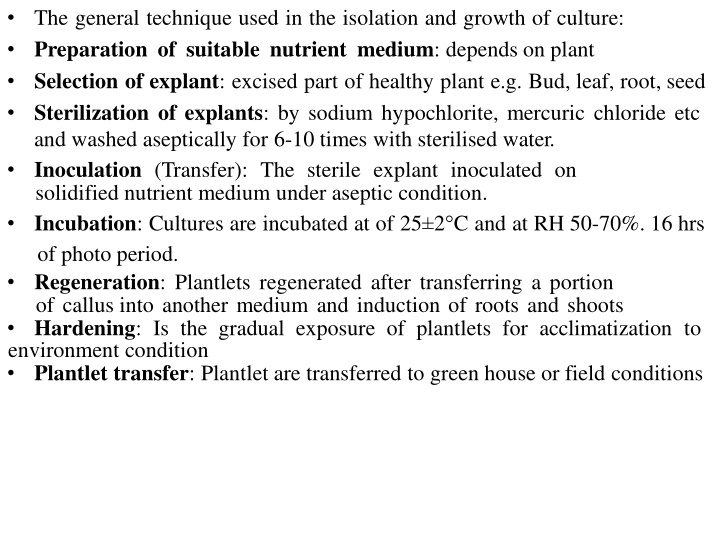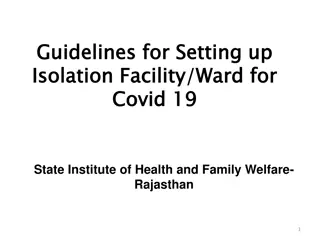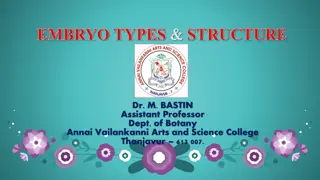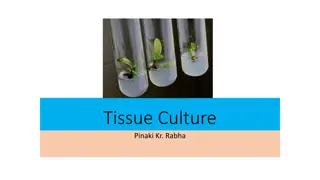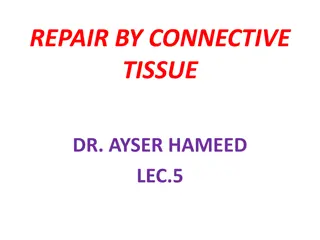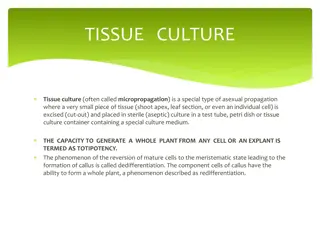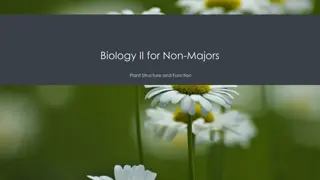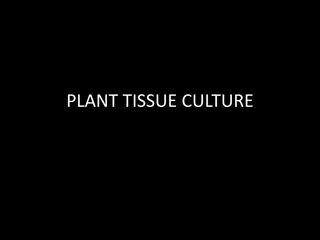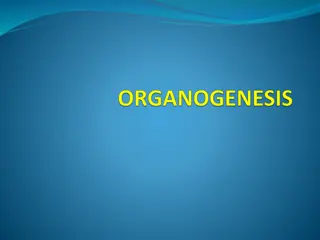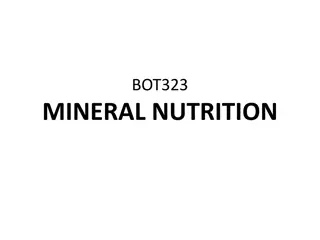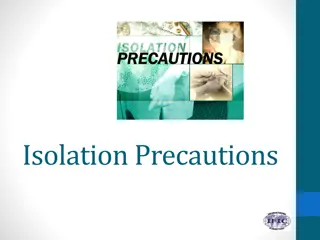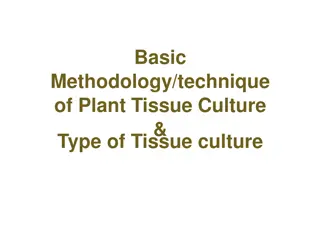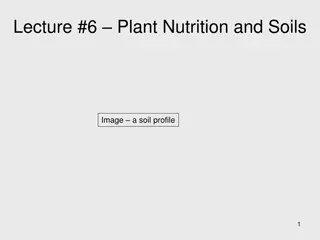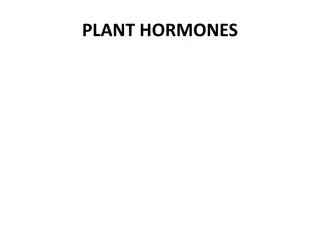Plant Tissue Culture Techniques: Isolation and Growth
Plant tissue culture involves preparing a suitable nutrient medium, selecting healthy plant explants, sterilizing them, inoculating on solid medium, incubating under controlled conditions, inducing regeneration, and hardening before transferring to greenhouse or field. Various types of cultures can be established depending on the medium type and plant part used, such as callus culture and organ culture. Understanding these techniques is crucial for successful plant propagation in vitro.
Download Presentation

Please find below an Image/Link to download the presentation.
The content on the website is provided AS IS for your information and personal use only. It may not be sold, licensed, or shared on other websites without obtaining consent from the author.If you encounter any issues during the download, it is possible that the publisher has removed the file from their server.
You are allowed to download the files provided on this website for personal or commercial use, subject to the condition that they are used lawfully. All files are the property of their respective owners.
The content on the website is provided AS IS for your information and personal use only. It may not be sold, licensed, or shared on other websites without obtaining consent from the author.
E N D
Presentation Transcript
The general technique used in the isolation and growth of culture: Preparation of suitable nutrient medium: depends on plant Selection of explant: excised part of healthy plant e.g. Bud, leaf, root, seed Sterilization of explants: by sodium hypochlorite, mercuric chloride etc and washed aseptically for 6-10 times with sterilised water. Inoculation (Transfer): The sterile explant inoculated on solidified nutrient medium under aseptic condition. Incubation: Cultures are incubated at of 25 2 C and at RH 50-70%. 16 hrs of photo period. Regeneration: Plantlets regenerated after transferring a portion of callus into another medium and induction of roots and shoots Hardening: Is the gradual exposure of plantlets for acclimatization to environment condition Plantlet transfer: Plantlet are transferred to green house or field conditions
Preparation of an explant Inoculation After incubation Selection of plant Various stages of plant growth Plant ready to be transferred into green house or hardening stage Regeneration of a plant from an explant 25
Laminar air flow Tissue culture rack 26
Types of Cultures Depending upon the type of medium Depending on the part used for culture 1. Depending upon the type of medium 1. 2. Culture Suspensi on culture Static culture (Callus culture) Semi- continuous culture Continuous culture Batch culture Open type Closed type Turbidostats chemostats 27
2. Depending on the part used for culture a) Organ Culture Root tip culture (Meristem - root tip culture) Shoot tip culture (Meristem - shoot tip culture) Leaves or leaf primordia culture Flower culture (Meristem - floral Anther and pollens culture Ovule and embryo culture Ovaries culture Nucellus culture Seed culture Cotyledon culture Endosperm culture Fruit culture Plant cell culture Hairy Root Culture Protoplast Culture and Somatic Hybridization i. ii. iii. iv. v. vi. vii. viii. ix. x. xi. xii. xiii. culture) b) c) 28
STATIC CULTURE (CALLUS CULTURE) Callus a mass of undifferentiated plant cells grown on solid from plant part/explant. It may initiate from explants of any multi-cellular plant. The organs such as root, stem tips, leaves, flowers and fruit are on solid media. The cell groups are initiated from: Explant/Segments of root, stem or leaf either from the mature or embryogenic plant Explant/Excised fragments of parenchyma or mixed tissue containing cambium or endosperm The longer the tissue explant the more complex the range of cell types & greater the possibilities of initiating a culture of mixed cells. Callus can be induced to undergo embryogenesis nutrient medium. T o study the biosynthetic pathway of various metabolic processes by using tracer elements in callus culture. It is useful for the production of secondary metabolites. media grown - - organogenesis and/or and eventually whole plant by providing suitable 29
SUSPENSION CULTURE It involves active proliferation of callus as undivided unit suspended or submerged in a liquid medium. The nutrient medium in this case is in constant agitation so as to prevent the cells from settling or aggregating in to clumps. Suspension cultures are normally initiated by transferring pieces of undifferentiated callus to a liquid medium which is agitated during incubation. 30
Batch Suspension Culture It means Culture in a fixed volume of culture medium . In general, a nutrient inoculum are mixed, aerated and allowed to grow In Batch cultures, as the cells grow, the medium is depleted of nutrients and metabolic byproducts from the cells accumulate. Batch cultures are characterized by - - continuous internal composition - accumulation of metabolic products. The system is closed with respect to additions or removal of culture, except for circulation of air. medium and cellular continuous changes in the medium changes in cellular 31
Semicontinuous Suspension Culture Here, the system is open . There is periodic removal of culture and the addition of fresh medium, due to which the culture is continuously maintained. growth of Continuous Suspension Culture The system is open here also. In this systems, and constant continuously to a fixed culture and withdrawn. volume of culture remains fresh medium volume is of added growing 32
Cell proliferation takes place under constant condition. This system allows - Establishment metabolism. Study of the changes which occur in transitions from steady state to another. Identification of the controlling factors. - Two types of Continuous Suspension Culture Open type 1. Regulated new medium and balancing volume of culture Chemostat Continuous new medium input is set at a predetermined rate and determine the equilibrium. Useful to study the steady states. Desired rate of growth is maintained by adjusting the level of concentration of nutrient of steady states of growth and one - harvest of equal nature of the resulting
Turbidostat Cell level properties of the culture) and new medium is added to maintain cell density within limits. Particularly densities. Offers effects of physical regulating associated metabolism. density is set at a (as monitored predetermined the by optical valuable for work at low cell a simplified system factors for study of and growth substance in growth rate and 34
2. Closed type The used medium is replaced with fresh medium, hence, the cells from used medium are mechanically separated and added back to the culture and thus, the cell biomass keeps increasing. 35
Organogenesis Organogenesis is a process involving redifferentiation meristematic cells present in callus into shoot buds or root even whole plantlets. of or The formation of organs is called organogenesis. The de-navo genesis of plant organ is broadly defined as organogenesis. 36
The shoot buds are monopolar structures which in turn give rise to leaf primordial and the apical meristem. The stimulation of shoot bud differentiation in plants depends on many factors which differ for different plant species. Skoog showed that auxin could stimulate rooting and inhibit shoot formation. Other factors affecting organogenesis are size and source of the explant. Light intensity plays an important role in organogenesis. High light intensity has been shown to be inhibitory for shoot bud formation in tobacco. 37
Even the quality of light has effect as blue light has been shown to induce shoot formation while red light stimulates rooting in tobacco. The optimum temperature required may vary with plant species. Amedium solidified with agar favours bud formation although there are some reports about the development of leafy shoot buds on cultures grown as suspension.
Embryogenesis Embryo is defined as the earliest recognisable multicellular stage of an individual that occurs before the development characteristic organs of the given species. Production of embryo like structure from callus is known as embryogenesis. In higher plants such embroys usually arise from zygote formation and are termed as zygotic embryos. V arious types of cells and tissues can be used as source of embryogenic cells. It may be microspores (1n), zygote (2n), somatic cells (2n) or somatic hybrids (4n). Embryogenesis can be induced in such cells by nonproliferative or proliferative direct embryogenesis or by growing embryogenic callus which in turn germinates and develops into whole plant. Embryogenesis can be initiated in an explant only from the more juvenile or meristematic tissues. Immature zygotic embryos, cotyledons and hypocotyl dissected from ungerminated seeds are common explants. Isolated somatic cells can develop into embroys. of 39
Embryo development occurs through an organised sequence of cell division, enlargement and differentiation. The final stages of development towards maturation are distinguished morphology. Somatic embryogenesis involves three distinct steps which are absent in organogenesis 1.Induction It is the initiative phase where cells of callus are induced to divide and differentiate into groups embryogenic clumps (ECs). These ECs develop into initial globular stage. 2.Maturation In this phase somatic embryos develop into mature embryos by differentiating from globular to heart shaped and the mature embryo here undergoesbiochemical changes to acquire hardness. 3.Conversion Embryos germinate to produce seedlings. by overall enlargement and matured embryo of meristematic cells called stages of somatic embryo i.e. 40
Advantages of Organogenesis & Embryogenesis 1. Efficiency of process (reduction in labour cost and time, the formation of plantlets is fewer steps) 2. The potential for the production of much higher number of plantlets and morphological and cytological uniformity of the plantlets. 3. Production of several plants on commercial scale includes food crops, plants. vegetables, spices, and fruits, medicinal and aromatic 41
2. Depending on the part used for culture a) Organ Culture Root tip culture (Meristem - root tip culture) Shoot tip culture (Meristem - shoot tip culture) Leaves or leaf primordia culture Flower culture (Meristem - floral Anther and pollens culture Ovule and embryo culture Ovaries culture Nucellus culture Seed culture Cotyledon culture Endosperm culture Fruit culture Plant cell culture Hairy Root Culture Protoplast Culture and Somatic Hybridization i. ii. iii. iv. v. vi. vii. viii. ix. x. xi. xii. xiii. culture) b) c) 42
